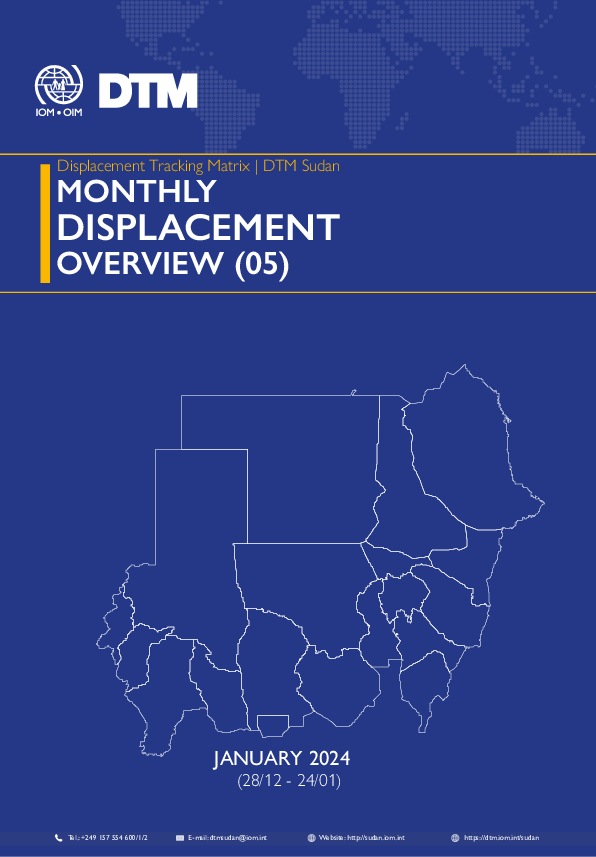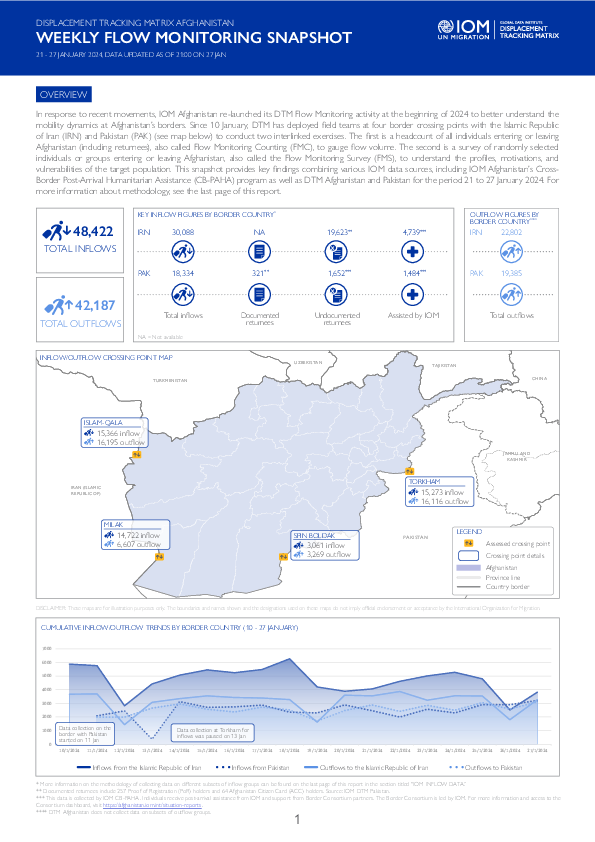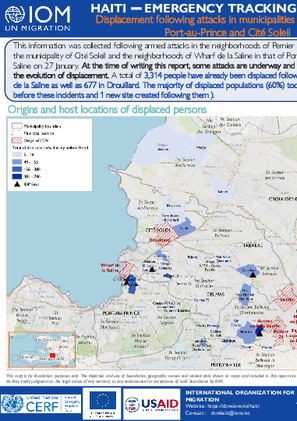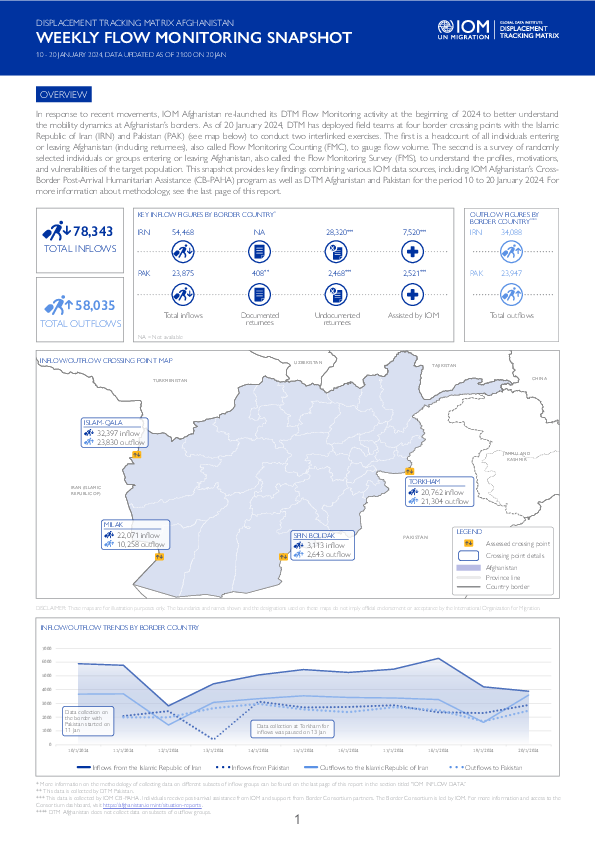-
Countries
-
Data and Analysis
-
Special Focus
-
Crisis Responses

Contact
DTM Sudan, DTMSudan@iom.int
Language
English
Location
Sudan
Period Covered
Dec 28 2023
Jan 24 2024
Activity
- Mobility Tracking
- Baseline Assessment
Overview
IOM DTM Sudan presents its fifth Monthly Displacement Overview. This publication provides an account of Sudan’s displacement context since 15 April 2023 – outlining population caseloads and movements, as well the present and evolving needs of Sudan’s growing IDP caseload.
Rationale
Recognizing the need for more detailed insights into the IDP situation, including the priority needs, access to services, movement intentions, and demographic breakdowns of the affected population, DTM Sudan has undertaken a comprehensive review of our data collection tool. In collaboration with a wide range of internal and external stakeholders, we have developed a new tool to better inform humanitarian response operations, aligning with the DTM global methodology. Leveraging our extensive network of approximately 367 field-based enumerators and a robust system of over 3,094 key informants across the country, DTM has gathered data on IDPs across 6,547 locations, in 177 of Sudan’s 189 localities – across all of Sudan’s 18 states.
Key Findings
- DTM Sudan estimates that 6,092,788 Individuals (1,213,683) Households) have been recently internally displaced.
- IOM DTM also reports that an estimated 1,720,890 mixed cross-border movements have been made into neighbouring countries.
- Since 15 April 2023, 45 per cent of the IDP caseload sought refuge in the Darfur and Kordofan regions, whereas 55 per cent were observed across the Northern, Eastern, and Central states.
- The majority of the IDP caseload (67%) were seeking shelter with the host community.
- While food security remains the highest priority need, health and non-food items are also growing concerns.
Contact
DTM Pakistan, DTMPakistan@iom.int
Location
Pakistan
Activity
- Survey
- Flow Monitoring
Period Covered
Jan 01 2023 -Dec 31 2023
The International Organization for Migration (IOM) in Pakistan collects data on the outflows of Afghans at the Torkham (Khyber Pakhtunkhwa) and Chaman (Balochistan) border crossing points (BCPs) to better understand the movements of Afghans returning to Afghanistan. The dataset is harmonised with those from the United Nations High Commissioner for Refugees (UNHCR), who also cover Ghulam Khan (Khyber Pakhtunkhwa), Badini and Bahramcha (Balochistan).
A more detailed version of this dataset containing information about the vulnerabilities is available, to get access kindly click on the 'Request Access' button
Population Groups
Returnee (Previously Displaced Abroad)
Survey Methodology
Unit of Analysis Or Observation
Other
Type of Survey or Assessment
Keywords
Geographical Scope
Administrative boundaries with available data
The current dataset covers the following administrative boundaries

Contact
DTM South Sudan, SouthSudanDTM@iom.int
Language
English
Location
South Sudan
Period Covered
Jan 01 2024
Jan 27 2024
Activity
- Survey
- Return Intention
On 27 January 2024, the IOM’s Displacement Tracking Matrix (DTM) in collaboration with WFP, ACTED, LWF, and Save the Children conducted a rapid intention survey in Renk TC and its adjacent area to understand the return intentions of the population, preferred destinations of return as well as reasons for choosing to remain in the transit center.

Contact
dtmlebanon@iom.int
Language
English
Location
Lebanon
Period Covered
Oct 10 2023
Jan 30 2024
Activity
- Mobility Tracking
- Baseline Assessment
Since October 8 there has been an increase in cross-border incidents between Israel and Lebanon, resulting in the displacement of people both within the South and elsewhere within the country. Since October 10, the Displacement Tracking Matrix (DTM) has been conducting the daily monitoring of population movements. The objective of the exercise is to inform preparedness and response planning.

Contact
DTMAfghanistan@iom.int
Language
English
Location
Afghanistan
Period Covered
Feb 21 2024
Feb 27 2024
Activity
- Survey
- Flow Monitoring Survey
- Flow Monitoring
In response to recent movements, IOM Afghanistan re-launched its DTM Flow Monitoring activity at the beginning of 2024 to better understand the mobility dynamics at Afghanistan’s borders. Since 10 January, DTM has deployed field teams at four border crossing points with the Islamic Republic of Iran (IRN) and Pakistan (PAK) (see map below) to conduct two interlinked exercises. The first is a headcount of all individuals entering or leaving Afghanistan (including returnees), also called Flow Monitoring Counting (FMC), to gauge flow volume. The second is a survey of randomly selected individuals or groups entering or leaving Afghanistan, also called the Flow Monitoring Survey (FMS), to understand the profiles, motivations, and vulnerabilities of the target population. This snapshot provides key findings combining various IOM data sources, including IOM Afghanistan’s Cross-Border Post-Arrival Humanitarian Assistance (CB-PAHA) program as well as DTM Afghanistan and Pakistan for the period 21 to 27 January 2024. For more information about methodology, see the last page of this report.
Contact
dtmlebanon@iom.int
Location
Lebanon
Activity
- Mobility Tracking
- Baseline Assessment
Period Covered
Oct 10 2023 -Jan 23 2024
Since October 8 there has been an increase in cross-border incidents between Israel and Lebanon, resulting in the displacement of people both within the South and elsewhere within the country. Since October 10, the Displacement Tracking Matrix (DTM) has been conducting the daily monitoring of population movements. The objective of the exercise is to inform preparedness and response planning.
Aggregated data is available through the DTM API: https://dtm.iom.int/data-and-analysis/dtm-api
A more detailed version of this dataset is available, to get access kindly click on the 'Request Access' button
Population Groups
IDPs
Survey Methodology
Unit of Analysis Or Observation
Admin Area 2
Admin Area 3
Household
Individual
Type of Survey or Assessment
Household
Key Informant
Keywords
Geographical Scope Full Coverage
Administrative boundaries with available data
The current dataset covers the following administrative boundaries

Contact
dtmhaiti@iom.int
Language
English
Location
Haiti
Period Covered
Jan 27 2024
Jan 31 2024
Activity
- Mobility Tracking
- Event Tracking
This information was collected following armed attacks in the neighborhoods of Pernier and its surroundings in the municipality of Pétion Ville, in the neighborhoods of Drouillard in the municipality of Cité Soleil and the neighborhoods of Wharf de la Saline in that of Port- au-Prince. Attacks in Pernier and Drouillard began on 30 January 2024 and at Wharf de la Saline on 27 January. At the time of writing this report, some attacks are underway and the displacement of populations as a result. Updates will be published by DTM according to the evolution of displacement. A total of 3,314 people have already been displaced following these attacks, including 1,398 following attacks in Pernier, 1,239 following those at Wharf de la Saline as well as 677 in Drouillard. The majority of displaced populations (60%) took refuge with host families and 40% in sites (1,331 people in 4 sites including 3 existing sites before these incidents and 1 new site created following them ).
Contact
DTMChad@iom.int
Location
Chad
Activity
- Mobility Tracking
- Site Assessment
- Village Assessment
Period Covered
Oct 05 2023 -Nov 08 2023
From October 5th 2023 to November 8th 2023, the DTM team in Chad has conducted the round 21 of Sites and Villages assessment accross 281 locations.
During this round, a total of 242,205 displaced individuals were identified, including 199,198 internally displaced persons, 27,090 internal returnees and 15,718 returnees from abroad.
Population Groups
IDPs
Returnee (Previously Displaced Abroad)
Returnee (Previously Internally Displaced)
Survey Methodology
Unit of Analysis Or Observation
Admin Area 2
Admin Area 3
Site
Site or Location
Type of Survey or Assessment
Key Informant
Keywords
Geographical Scope Partial Coverage
Administrative boundaries with available data
The current dataset covers the following administrative boundaries

Contact
DTM Burundi, DTMBurundi@iom.int
Language
French
Location
Burundi
Period Covered
Jan 21 2024
Jan 27 2024
Activity
- Mobility Tracking
- Event Tracking
La DTM a identifié 2 785 personnes affectées, dont 141 personnes déplacées par les pluies torrentielles et la grêle dans les provinces de Cankuzo, Kayanza, Gitega, Rutana et Makamba.

Contact
DTMAfghanistan@iom.int
Language
English
Location
Afghanistan
Period Covered
Jan 10 2024
Jan 20 2024
Activity
- Survey
- Flow Monitoring Survey
- Flow Monitoring
In response to recent movements, IOM Afghanistan re-launched its DTM Flow Monitoring activity at the beginning of 2024 to better understand the mobility dynamics at Afghanistan’s borders. Since 10 January, DTM has deployed field teams at four border crossing points with the Islamic Republic of Iran (IRN) and Pakistan (PAK) (see map below) to conduct two interlinked exercises. The first is a headcount of all individuals entering or leaving Afghanistan (including returnees), also called Flow Monitoring Counting (FMC), to gauge flow volume. The second is a survey of randomly selected individuals or groups entering or leaving Afghanistan, also called the Flow Monitoring Survey (FMS), to understand the profiles, motivations, and vulnerabilities of the target population. This snapshot provides key findings combining various IOM data sources, including IOM Afghanistan’s Cross-Border Post-Arrival Humanitarian Assistance (CB-PAHA) program as well as DTM Afghanistan and Pakistan for the period 10 to 20 January 2024. An interactive dashboard on all data collected since the inception of the Flow Monitoring activity on 10 January can be found HERE.
